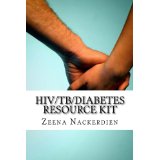Perspectives on Type 2 Diabetes’ and the Resource Kit

Following the death of my brother in 2013 due to Type 2 diabetes-related complications, the reality of
an uncontrolled, treatable condition hit home in a big way. As a means of processing this pain, I began
taking a closer look at the disease, including revisiting a book and exhibit on insulin. This blog post,
previously published on the Norwalk Patch and on my own site, is a synopsis of the story behind the
discovery of insulin:
“Pharmaceutical company” and “doing the right thing” are words that do not belong in the same
sentence, if critics are to be believed. Inflammatory rhetoric amplifies known examples justifying
negative publicity. Therefore, one could have been forgiven for having viewed a past exhibit at the New-York Historical Society with a measure of skepticism. The title of the exhibit was: “Breakthrough–The Dramatic Story of the Discovery of Insulin and the Era of Hope,” co-sponsored by the pharmaceutical company, Eli Lilly. For a brief moment one was transported to an almost-forgotten success story, in which academia and industry collaborated positively towards conquering a hitherto incurable disease.
The narratives, photos, and videos focusing on the researchers involved in the prelude to, and actual discovery of, insulin drew immediate attention. Diabetes mellitus, the latter word derived from the Latin for “honey,” had affected sufferers for centuries, as evidenced by historical quotes (Aretaeus, the famed Second-century physician from Cappadocia, who practiced in Greece and Rome, referred to diabetes in terms of “the melting down effect on flesh and limbs”) and diagnoses, e.g. descriptions on an Egyptian papyrus of sweet-smelling urine characteristic of the disease. The anatomy and physiology homage to the boomerang-shaped pancreas and histological stains highlighting the islets of Langerhans provided insights into some of the methods used to study the disease.
Many people were also fascinated by the stories of the scientific pioneers. Dr. Elliott P. Joslin was acknowledged for making patient involvement and empowerment the key features of diabetes management. Dr. Frederick Allen, an alumnus of The Rockefeller University in New York City, showed that diets below 1000 calories could lower blood sugar levels. The shoulders of these and other research giants formed the platforms for the men who would eventually share the Nobel Prize in Physiology and Medicine in 1923 for the discovery of insulin, Drs. Frederick Banting and John Macleod. The two discoverers shared their cash awards with Best and Collip, two contributors to the work.
Their studies are further elaborated upon in a book, “Breakthrough: Elizabeth Hughes, the Discovery of Insulin, and the Making of a Medical Miracle,” written by Thea Cooper and Arthur Ainsberg. The image of Banting that coalesced from the book was one of a loner, with no sense of purpose when he first enrolled in freshman classes at the University of Toronto. Contrast Banting’s persona with that of Professor John Macleod, a Scottish recruit to the University of Toronto and an authority on carbohydrates and metabolism, and one begins to grasp why there was discord between the two men.
At the start of his research, Dr. Banting was already aware of the elusive secretions from the pancreas that could normalize blood sugar levels. However, because of degradation caused by digestive enzymes, no one in the English-speaking world had been able to isolate this secretion. In 1916, the Romanian scientist, Nicolas Paulesco, was successful in normalizing the blood sugar levels of dogs by injecting them with an extract called “pancrein,” but this success was not yet widely known. So much of Dr. Banting’s early work was conducted in a vacuum, with only his assistant, Charles Best, serving as an immediate sounding board for his ideas. Endless months of labor by both of them finally paid off when dog 408, a collie, finally responded positively to injections of the pancreatic extract. Buoyed by ensuing successes,
Dr. Banting drafted a seminal paper titled “The Beneficial Influences of Certain Pancreatic Extracts on Pancreatic Diabetes,” that would eclipse all prior discoveries in the field. Enter Big Pharma in the form of Alec Clowes, the man charged with identifying medical projects with commercial potential for Eli Lilly. According to the book, Eli Lilly, the grandson of the company’s founder, was a man who thought that the future of the company hinged on patenting fundamentally new ideas, not improvements of old ideas. Basing his thoughts on the successful collaboration between inventors, George Westinghouse and Thomas Edison, he proposed that basic biological research could provide the source of information enabling pharmaceutical companies to develop and patent entirely new proprietary drugs. Risk was not new to the Lilly family. Colonel Lilly built the first plant in 1895 to manufacture gelatin capsules, in essence a more palatable delivery mechanism for unpalatable medications.
The transfer of production rights from Toronto to the Lilly plant in Indianapolis was by no means a straightforward exercise. It seemed as if every short-term victory was followed by failure, with batches of variable quality insulin being produced, and insulin shortages becoming a huge issue. Diabetes specialists were also faced with the ethical dilemma of whom to treat and whom to turn away. Through a large monetary investment by Lilly and further interactions between the Canadian group and Mr. Clowes, large-scale production of insulin was finally undertaken at the Indianapolis plant.
Celebrities often bring more attention to a cause, and this was the case with Elizabeth Hughes (daughter of the Supreme Court Justice Evans Charles Hughes), who went on to live a full and productive life after receiving insulin.
Fast forward to the present day, and the rising numbers of diabetes sufferers seem to overshadow the successes from this positive academic-industry collaboration. In 2006, the United Nations passed a resolution declaring diabetes as serious a health threat as infectious diseases such as HIV/AIDS. As if to reinforce that theme, the exhibit concluded with flickering images of children in the developing world walking long distances to a clinic to receive life-saving medications. The International Diabetes Federation’s Life for a Child Program supports the care of children in 26 countries worldwide; benefits from the sale of the book on the discovery of insulin will also go towards its activities.
YouTube videos and images covering more aspects relating to the insulin story can still be found on the New York Historical Society web site.
Perspectives on Type 2 Diabetes by Zeena Nackerdien:
Publisher: Create Space (April 20, 2015)
CategoryNon-Fiction, Health, Type 2 Diabetes, HIV, TB, Patient Empowerment
Tour Dates: October/November, 2015
ISBN: 978-1511734837
ASIN: B00WGR90VK
Available in: Print & ebook, 41 Pages
The rising socioeconomic toll of diabetes, in particular, the Type 2 form of the disease, is reverberating around the world. A disease that has sporadically plagued mankind for centuries seems to have increased in prevalence in tandem with rapid economic transitions, notably in countries with the highest number of diabetics such as China and the USA.
This resource guide is comprised of information about diabetes in those countries as well as in the Middle East, North Africa, and South Africa. In addition, the latest antidiabetic therapies and infectious comorbidities associated with the disease are discussed in separate chapters. Scattered throughout the guide are fictional scenarios about challenges diabetics and their doctors might face in individualizing recommended management algorithms.
Praise for Perspectives on Type 2 Diabetes by Zeena Nackerdien:
Type 2 diabetes, characterized by the body’s progressive inability to utilize insulin, is rapidly approaching a prevalence of one in ten (9.3% in 2014) in both the U.S. and China. This silent epidemic manifests itself initally as a rise in blood sugar.
Dr. Nackerdien found herself challenged by signs of the early stages of this condition and has produced an excellent summary of early intervention goals and guidelines. This “translation” of technical information to an understandable guideline format is a must-have for real people who find themselves on the cusp of this debilitating condition.”- Curt, Amazon Reviewer
 HIV/TB/Diabetes Resource Kit by Zeena Nackerdien:
HIV/TB/Diabetes Resource Kit by Zeena Nackerdien:
Publisher: Create Space (April 23, 2015)
CategoryNon-Fiction, Health, Type 2 Diabetes, HIV, TB, Patient Empowerment
Tour Dates: October/November, 2015
ISBN: 978-1511864060
ASIN: B00WMNRDWG
Available in: ebook, 35 Pages
Who are the groups likely to be in the frontlines of either administering or receiving anti-HIV/AIDS-containing treatments for this disease and any associated comorbidities? The answer is frontline healthcare professionals, lay educators, and patients, especially in high-disease burden countries such as South Africa. While the reinvigorated national response to HIV/AIDS underscores the country’s commitment to the health crisis, the socioeconomic costs are likely to have a lasting impact on its citizens.
I have compiled a resource kit outlining some of the challenges faced in the treatment of patients with HIV, TB, and diabetes. In addition, the kit contains disease management and prevention tips suited for discussions with healthcare professionals, particularly in resource-poor settings.
About Zeena Nackerdien:
Zeena Nackerdien is a dual US and South African citizen. She obtained a PhD degree in Biochemistry from the University of Stellenbosch in South Africa. Zeena has been a research chemist at the National Institute of Standards and Technology in Maryland and a senior research associate at The Rockefeller University in New York.
She is the author of several publications in scientific journals and two poetry collections, “Mist Over Peace” and “Scatterlings.” As a scientist turned patient advocate and writer, she is intensely interested in building relationships with people from different cultures through story-telling and education. Zeena currently lives in Brooklyn, New York.
Website: http://www.heroinenextdoor.com/
Facebook: https://www.facebook.com/zeenasbooks
Google+: https://plus.google.com/105525451604342478576/posts
LinkedIn: https://www.linkedin.com/pub/zeena-nackerdien/9/175/b6a
Pinterest: https://www.pinterest.com/zulu2/zeena-nackerdien/
Buy Perspectives on Type 2 Diabetes by Zeena Nackerdien:
Amazon
Barnes & Noble
Book Depository
Buy HIV/TB/Diabetes Resource Kit by Zeena Nackerdien:
What's Your Reaction?
Newly middle-aged wife of 1, Mom of 3, Grandma of 2. A professional blogger who has lived in 3 places since losing her home to a house fire in October 2018 with her husband. Becky appreciates being self-employed which has allowed her to work from 'anywhere'. Life is better when you can laugh. As you can tell by her Facebook page where she keeps the humor memes going daily. Becky looks forward to the upcoming new year. It will be fun to see what 2020 holds.






